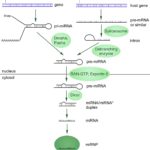Paper, Eating microRNAs
Cross‐kingdom communication via non‐coding RNAs is a recent discovery. Exogenous microRNAs (exog‐miRNAs) mainly enter a host through diet. Generally considered unstable in the gastrointestinal (GI) tract, some exogenous RNAs may resist these harsh conditions, especially if transported in extracellular vesicles. They could then reach the intestines and more probably exert a regulatory effect. We provide an overview of recent discoveries concerning dietary miRNAs, possible ways of enhancing their resistance to technological processing and GI conditions, their transport in extracellular vesicles (animal‐ and plant‐origin) and their possible biological effects on recipient cells after oral ingestion. We critically focus on what we believe are the most relevant data for future pharmacological development of dietary miRNAs as therapeutics. Finally, we discuss the miRNA‐mediated cross‐kingdom regulation between diet, host and the gut microbiota. We conclude that, despite many obstacles and challenges, extracellular miRNAs are serious candidates for pharmacological development.
Learn about our two Decals!
 Click here to find out more about our Fall Bioinspired Design Decal and our Spring Bioinspired Design in Action Decal – ALL MAJORS are welcome.
Click here to find out more about our Fall Bioinspired Design Decal and our Spring Bioinspired Design in Action Decal – ALL MAJORS are welcome.Berkeley BioDesign Community
 Click here to learn about the BioD: Bio-Inspired Design @ Berkeley student organization or here to signup for more info.
Click here to learn about the BioD: Bio-Inspired Design @ Berkeley student organization or here to signup for more info.Search
Student Login




I imagine that the neurological circuits underlying these processes are governed by both 2d spacing maps with their brains as…
to reduce the impact of car accidents, it may be possible to study the force diverting physics of cockroaches to…
you see this type of head-bobbing stability in many avian creatures related to pigeons like chickens. the head ability to…
not like they taught horses how to run! this is an example of convergent evolution where both sea creatures and…
The brain functions in a similar way with neuronal connections. our brains are able to utilize the multiplicity of connections…